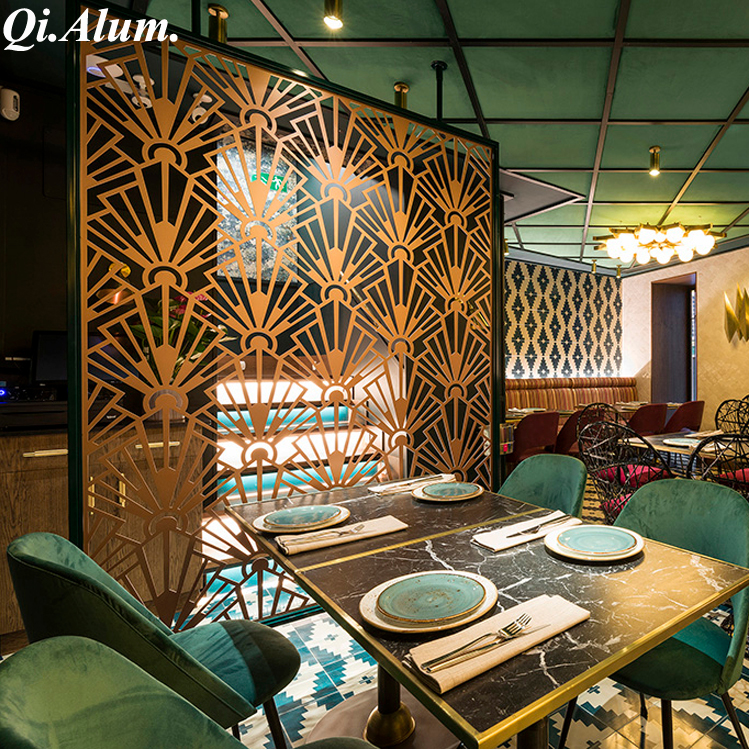Indoor aluminum veneer is a composite material made of chemically treated coated aluminum plate as surface material, polyethylene plastic as core material, and processed on special indoor aluminum veneer production equipment. The unique performance of aluminum-plastic composite board determines its wide use: it can be used for building exterior wall, curtain wall board, renovation of old building, interior wall and ceiling decoration, advertising signs, display bench, dust purification engineering.
Indoor aluminum veneer is composed of multilayer materials, the upper and lower layers are high purity aluminum alloy, the middle is non-toxic low density polyethylene (PE) core board, the front is also pasted with a layer of protective film. For outdoor, the front of the indoor aluminum veneer is coated with fluorocarbon resin (PVDF) coating; for indoor, the front of the aluminum veneer is coated with non-fluorocarbon resin coating.
Indoor aluminum veneer classification
Indoor aluminum veneer varieties are more, and is a new material, so there is no unified classification method, usually according to the use, product function and surface decoration effect classification.
1. Classification by product functions
A. Fire prevention board
Flame retardant core material is selected, and the combustion performance of the product reaches inflammable grade (B1) or non-combustible grade (A);
At the same time, other performance indicators shall also conform to the technical requirements of indoor aluminum veneer.
B. Antibacterial and mildew-proof indoor aluminum veneer
The coating with antibacterial and bactericidal effect is coated on the indoor aluminum veneer, so that it has the function of controlling the reproduction of microbial activities and finally killing bacteria.
C. Anti-static indoor aluminum veneer
Antistatic indoor aluminum coated indoor aluminum veneer veneer using antistatic coating, surface resistivity under 109 Ω m., smaller than common indoor aluminum veneer surface resistivity, therefore not easy to produce static electricity, dust in the air of not easy also attached on the surface.
2, according to the surface decoration effect to classification
A. Coated interior aluminum veneer
A variety of decorative coatings are applied to the surface of aluminum plates.
The commonly used fluorocarbon, polyester, acrylic coating, mainly including metal color, plain color, pearl color, fluorescent color and other colors, with decorative effect, is the most common varieties in the market.
B. Oxidized colored indoor aluminum veneer
The anodized aluminum alloy panel has unique colors such as rose red and bronze color, which has special decorative effect.
C. Laminate decorative composite board
That is, the color film according to the set process conditions, depending on the role of adhesive, so that the color film adhesive in the primer on the aluminum plate or directly attached to the aluminum plate after degreasing treatment.
Main breed has grain, wood grain board to wait.
D. Color printed indoor aluminum veneer
Different patterns are printed on the transfer paper by advanced computer phototypesetting printing technology, and various imitation natural patterns are printed on the transfer paper by color ink, and then copied indirectly on the indoor aluminum veneer by heat transfer printing technology.
Can satisfy the originality of stylist and the individual choice of owner.
E. Wire-drawing indoor aluminum veneer
The aluminum alloy panel that USES surface to be processed by drawing wire, common is product of gold drawing wire and silver drawing wire, bring different visual experience to the person.
F. Aluminum veneer for mirror interior
The surface of the aluminum alloy panel is polished to look like a mirror.
3. Categorize by purpose
A. Indoor aluminum veneer for building curtain wall
The minimum thickness of the upper and lower aluminum plates shall not be less than 0 and 50mm, and the total thickness shall not be less than 4mm.
The aluminum material shall meet the requirements of GB/T 3880, and generally adopt series of aluminum alloy plates such as 3000 and 5000, and the coating shall adopt fluorocarbon resin coating.
B. Indoor aluminum veneer for exterior decoration and advertising
The upper and lower aluminum plates shall be made of rust-proof aluminum with a thickness of no less than 0 and 20mm, and the total thickness shall be no less than 4mm.
The coatings are generally fluorocarbon coated or polyester coated.
C. Indoor aluminum veneer for indoor use
The upper and lower aluminum plates generally adopt aluminum plates with a thickness of 0 and 20mm, and the minimum thickness is not less than 0 and 10mm. The total thickness is generally 3mm.
The coating is polyester coated or acrylic coated.



